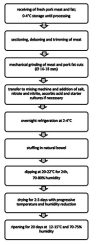Evaluation of vacuum packaging for extending the shelf life of Sardinian fermented sausage
- PMID: 37405145
- PMCID: PMC10316266
- DOI: 10.4081/ijfs.2023.10819
Evaluation of vacuum packaging for extending the shelf life of Sardinian fermented sausage
Abstract
Salsiccia sarda or Sardinian fermented sausage is a traditional dry-fermented sausage included in the list of traditional food products of Sardinia (Italy). At the request of some producing plants, the possibility of extending the shelf life of the vacuum-packed product up to 120 days was evaluated. Manufacturing of 90 samples, representing 3 different batches of Sardinian fermented sausage was carried out in two producing plants (A and B). In the packaged product and subsequently every 30 days for four months (T0, T30, T60, T120), the following analyses were conducted on all samples: physicochemical characteristics, total aerobic mesophilic count, Enterobacteriaceae count, detection of Listeria monocytogenes, Salmonella spp., mesophilic lactic acid bacteria, and coagulase-positive Staphylococci. Moreover, surfaces in contact and surfaces not in contact with food were sampled in both producing plants. Sensory profile analysis was also performed for every analysis time. At the end of the extended shelf life, pH values were equal to 5.90±0.11 (producing plant A) and 5.61±0.29 (producing plant B). Water activity mean values at T120 were 0.894±0.02 (producing plant A) and 0.875±0.01 (producing plant B). L. monocytogenes was detected in 73.3% (33/45) of the samples from producing plant A, with mean levels of 1.12±0.76 log10 CFU/g. In producing plant B, L. monocytogenes was never detected. Enterobacteriaceae were detected in 91.1% (41/45) of samples in producing plant A with mean values of 3.15±1.21 log10 CFU/g, and in 35.5% (16/45) samples in producing plant B samples with mean values of 0.72±0.86 log10 CFU/g. Salmonella and Staphylococcus aureus were never detected. Regarding environmental samples, the sites that were most contaminated by L. monocytogenes were the bagging table (contact surface) and processing room floor drains (non-contact surface) with a prevalence of 50% each (8/16 positive samples for both sampling sites). Sensory analysis results showed that at T30 the overall sensory quality was at its highest;moreover, the visual-tactile aspect, the olfactory characteristics, the gustatory aspects, and the texture showed significant differences in samples throughout the shelf life, with a decreased intensity at 120 days of storage. Overall, the quality and sensory acceptance of the vacuumpacked Sardinian fermented sausage was not affected until 120 days of shelf-life. However, the possible contamination by L. monocytogenes calls attention to the hygienic management of the entire technological process. The environmental sampling was confirmed as a useful verification tool during control.
Keywords: fermented sausage; microbial shelf life; processing surfaces; vacuum package.
©Copyright: the Author(s).
Conflict of interest statement
Conflict of interest: the authors declare no potential conflict of interest.
Figures


Similar articles
-
Survival of Naturally Contaminating Listeria monocytogenes in Commercial Mediterranean-Style Dry Fermented Sausages during Storage.J Food Prot. 2022 Nov 1;85(11):1576-1583. doi: 10.4315/JFP-22-023. J Food Prot. 2022. PMID: 35499450
-
Selection of commercial protective cultures to be added in Sardinian fermented sausage to control Listeria monocytogenes.Ital J Food Saf. 2022 Jun 27;11(2):10368. doi: 10.4081/ijfs.2022.10368. eCollection 2022 Jun 21. Ital J Food Saf. 2022. PMID: 35832037 Free PMC article.
-
Non-thermal inactivation of Listeria spp. in a typical dry-fermented sausage: "Bergamasco" salami.Ital J Food Saf. 2019 Oct 2;8(3):8112. doi: 10.4081/ijfs.2019.8112. eCollection 2019 Sep 30. Ital J Food Saf. 2019. PMID: 31632928 Free PMC article.
-
Lessons from the organization of a proficiency testing program in food microbiology by interlaboratory comparison: analytical methods in use, impact of methods on bacterial counts and measurement uncertainty of bacterial counts.Food Microbiol. 2006 Feb;23(1):1-38. doi: 10.1016/j.fm.2005.01.010. Food Microbiol. 2006. PMID: 16942983 Review.
-
High-Hydrostatic-Pressure (HHP) Processing Technology as a Novel Control Method for Listeria monocytogenes Occurrence in Mediterranean-Style Dry-Fermented Sausages.Foods. 2019 Dec 12;8(12):672. doi: 10.3390/foods8120672. Foods. 2019. PMID: 31842401 Free PMC article. Review.
Cited by
-
Protective Effect of Lactic Acid Bacteria Isolated from Ripened Foods Against Listeria monocytogenes in Plant-Based Fermented Dry-Cured Sausages.Foods. 2025 Apr 24;14(9):1491. doi: 10.3390/foods14091491. Foods. 2025. PMID: 40361574 Free PMC article.
-
Sardinian fermented sausage traditional production process: a preliminary survey in eight establishments.Ital J Food Saf. 2024 Aug 2;13(4):12203. doi: 10.4081/ijfs.2024.12203. eCollection 2024 Nov 12. Ital J Food Saf. 2024. PMID: 39749181 Free PMC article.
References
-
- Barbuti S, Parolari G, 2002. Validation of manufacturing process to control pathogenic bacteria in typical dry fermented products. Meat Sci 87:264-73. - PubMed
-
- Bourdichon F, Betts R, Dufour C, Fanning S, Farber J, McClure P, Stavropoulou DA, Wemmenhove E, Zwietering MH, Winklerk A, 2021. Processing environment monitoring in low moisture food production facilties: are we looking for the right microorganisms? Int J Food Microbiol 356:109351. - PubMed
-
- Casquete R, Benit MJ, Martin A, Ruiz-Moyano S, 2012. Comparison of the effects of a commercial and an autochthonous Pediococcus acidilactici and Staphylococcus vitulus starter culture on the sensory and safety properties of a traditional Iberian dry-fermented sausage salchichon. J Food Sci Technol 47:1011-9.
-
- Cenci-Goga BT, Rossitto PV, Sechi P, Parmegiani S, Cambiotti V, Cullor JS, 2012. Effect of selected dairy starter cultures on microbiological, chemical and sensory characteristics of swine and venison (Dama dama) nitrite-free dry-cured sausages. Meat Sci 90:599-606. - PubMed
-
- Daga E, Mannu L, Porcu S, Comunian R, Paba A, Scintu MF, 2007. Home-made dry sausages produced in Sardinia: an investigation on the microflora. Ital J Food Sci 19:297:308.
LinkOut - more resources
Full Text Sources
Miscellaneous

